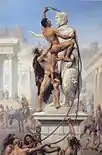
Photograph of Sylvestre taken sometime between 1876 and 1894
Joseph-Noël Sylvestre (24 June 1847 – 29 October 1926) was a French artist, notable for his studies of classic scenes from antiquity.[1]
Life
Joseph-Noël Sylvestre was born on 24 June 1847 in Béziers in South-West France.
He began his training as an artist first in Toulouse under Thomas Couture, then at the École des Beaux-Arts in Paris under Alexandre Cabanel.[1] He was an exponent of the romantic Academic art style, also known as art pompier (fireman's art), examples of which are the Death of Seneca (1875), The Gaul Ducar decapitates the Roman general Flaminius at the Battle of Trasimene (1882), The Sack of Rome by the barbarians in 410 (1890) and François Rude working on the Arc de Triomphe (1893).
Gallery
 The Death of Seneca (1875)
The Death of Seneca (1875).jpg.webp) The Gaul Ducar decapitates the Roman general Gaius Flaminius at the Battle of Lake Trasimene (1882)
The Gaul Ducar decapitates the Roman general Gaius Flaminius at the Battle of Lake Trasimene (1882) The Sack of Rome by the barbarians in 410 (1890).
The Sack of Rome by the barbarians in 410 (1890). François Rude working on the Arc de Triomphe (1893).
François Rude working on the Arc de Triomphe (1893).
References
- 1 2 Joseph-Noël Sylvestre. Peintre pompier biterrois (1847–1926) (in French). Archived 2011-02-23 at Wikiwix (Exhibition catalogue, Musée des Beaux-Arts, Béziers, October 2005).
Sources
- This article began as a translation of its French equivalent.
This article is issued from Wikipedia. The text is licensed under Creative Commons - Attribution - Sharealike. Additional terms may apply for the media files.